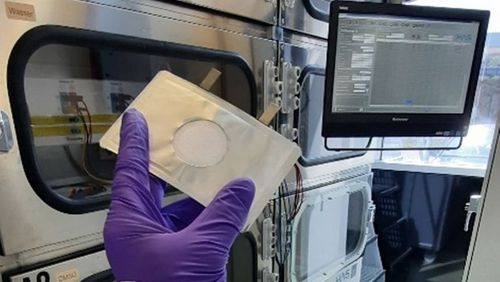In a nationwide collaboration, a group of chemists has created and analysed a new and promising carbon compound. A research group at the University of Oldenburg led by Professor Gerhard Hilt provided the basic building block for the material.
A new miracle material? “That would be nice,” says Prof. Dr. Gerhard Hilt with a grin. However, the new carbon compound created, analysed and described by scientists from Oldenburg, Marburg, Gießen and Erlangen can be viewed as a “cousin” of the material graphene - according to the science journal „Nature“. And like graphene which won its creators a Nobel Prize it appears to possess exciting properties.
“We don’t know yet the exact electronic or other properties of the material” stresses Hilt, whose specialist field is organic chemistry, or in other words carbon-based chemical compounds. “As things stand now, we’ve produced a small amount covering an area of one square centimetre, so we still have a long way to go. But we’ve made a start!”
The path to the new material, a so-called azulene polymer, began with a blue-green powder which Hilt brought home to Marburg at the end of a working week from the Campus in Oldenburg. Three years after his transfer to Oldenburg Hilt continues to work closely with his colleague Prof. Dr. Michael Gottfried of the Department of Physical Chemistry at Philipps University of Marburg. “Sometimes I also bring him a little white powder on the train,” he says with a wink.
Unusual properties
But in this case the powder in question was azulene. The bluish-green substance consists of ten carbon and eight hydrogen atoms (C10H8), just like the colourless compound naphthalene found in mothballs, which is also a basic building block for graphene. But it has a slightly different structure: whereas naphthalene consists of two interlinked hexagonal structures called rings, azulene consists of a five-member and a seven-member ring, which are also connected on one side.
In 2004, scientists for the first time succeeded in combining a sheet of six-membered carbon rings into one large molecule. The material thus produced, graphene, is said to be more than a hundred times stronger than steel and as conductive as silicon, yet as a two-dimensional carbon compound it is also extremely thin, light, flexible and transparent.
Gottfried, Hilt and colleagues wanted to make similar structures out of five and seven-membered rings. Theory predicted that such large molecular structures, known as polymers, would have unusual properties, but no one had so far succeeded in making them, because when heated the five-member and seven-member rings are prone to rearranging their bonds to form the more stable hexagonal carbon rings.
From molecular chains to nanoribbons
Hilt provided the basic building block for the new polymer. His team had the task of synthesising azulene to the highest possible degree of purity: They produced a so-called dibromazulene, that is azulene with two bromine atoms, as starting material. The chemists in Marburg then synthesised chains of five and seven-member rings on a gold surface in a high-vacuum apparatus.
“By heating the surface very carefully, the chains are coupled with each other. The resulting molecules are attracted to the gold and are so large and heavy that they remain lying on the surface despite the vacuum,” Hilt explains. Through this procedure the chains were turned into ribbons of molecules known as nanoribbons. The researchers would now like to create a larger area of the new material, says Hilt. But the challenge would be to heat the rings to exactly the right temperature, because otherwise they could end up with graphene instead.
Plenty of attention among scientific community
The properties and applications of the new carbon polymer have yet to be determined. The proposed applications for graphene, which has a 15-year head start, range from ultra-fast computer transistors, incredibly long-lasting phone batteries and flexible, transparent displays to ultra-sensitive biochemical sensors which could for example be used in explosives. However, that material is not yet producible on an industrial scale. And with the azulene polymer there is also still a long way to go between research and concrete applications.
Nonetheless, the paper published by Gottfried, Hilt and their colleagues from Gießen and Erlangen has attracted plenty of attention, at least among the scientific community: originally published in the Journal of the American Chemical Society, Nature featured it as a highlight, and within just a few weeks it was downloaded more than 3,000 times.






